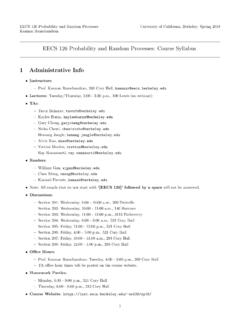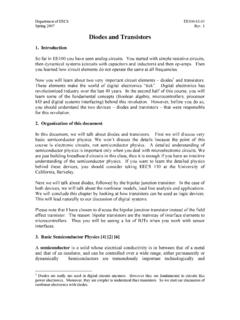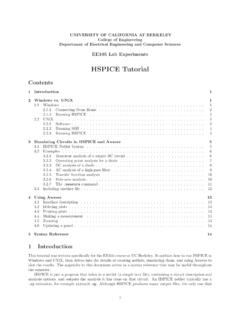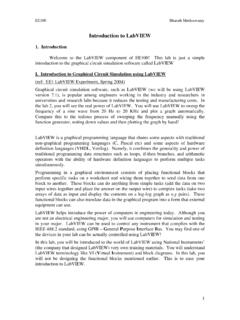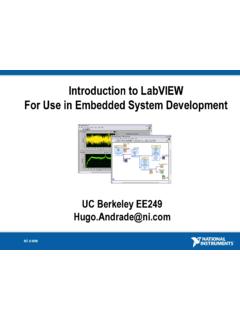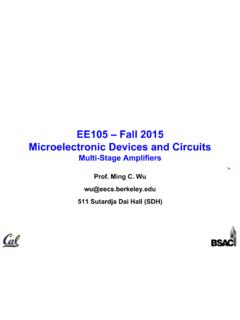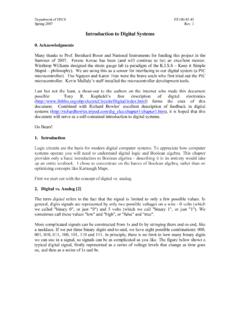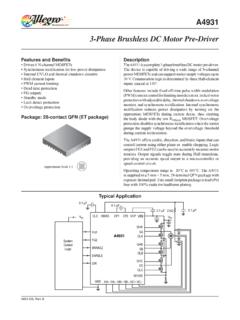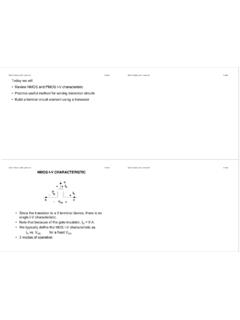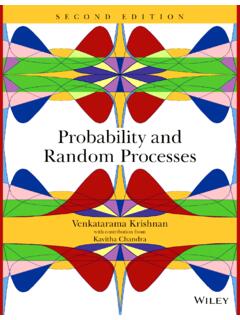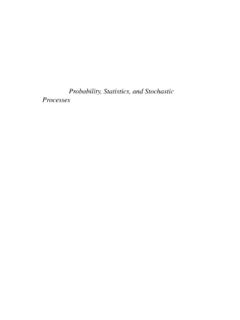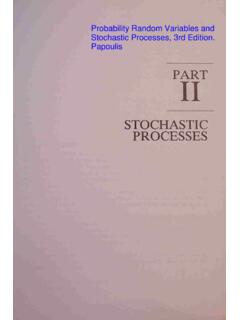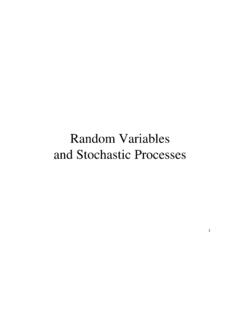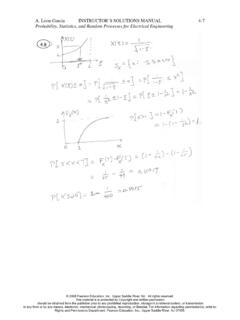Transcription of EE126: Probability and Random Processes - Lecture 1 ...
1 OutlineLogisticsIntroductionModelExample sEE126: Probability and Random ProcessesLecture 1: Probability ModelsAbhay ParekhUC BerkeleyJanuary 18, 2011 OutlineLogisticsIntroductionModelExample s1 Logistics2 Introduction3 Model4 ExamplesOutlineLogisticsIntroductionMode lExamplesWhat is this course about?Most real-world problems involve uncertainty1 Predictions:Will you like this class? Will you get an A ?Will the Giants win the world series next year? What are theodds?2 Strategy/Decision MakingHow should you bet in blackjack?Should you buy shares of AAPL?
2 3 EngineeringHow should you build a spam filter?How should you build a wifi system? Probability is a mathematical discipline that allows oneto reasonabout uncertaintyOutlineLogisticsIntroductionM odelExamplesWhat is this course about?Two equally important skills taught in this classUnderstand the problemCombinatorics, Calculusas an experimentMany students get stuck on the first block. Solve lots Framework: The ExperimentConcept1 The experiment hasbaseoutcomes2 These outcomes areexhaustive and mutuallyexclusive3 Each base outcome,eisassigned a non-negativenumberP(e) called itsprobability4 The probabilities summedover all of the base outcomesalways equals 1 Example.
3 Toss a fair cointwice1 Base outcomes areHH,HT,TH,TT2 This of these outcomes isequally likely4 Assign each outcome aprobability of list (set) of base outcomes is called theSample rules by which probabilities are assigned are theAxioms Space, 1 Toss a Coin 3 times2 Pick 3 balls from an urn with 2 Red and 3 Black Balls3 Toss a coin until the first H appearsOutlineLogisticsIntroductionModel ExamplesEvent: A(ny) subset of the Sample Space1E1: Get 2 Heads when experiment is to toss a Coin 3 times2E2: Get 1 Black and 2 Reds when exp is to pick 3 balls froman urn with 2 Red and 3 Black Balls3E3: Even number of tosses when exp is to toss a coin until thefirst H appears4 Always events:The base outcomes; The set of all baseoutcomes, and the null outcome{}.
4 OutlineLogisticsIntroductionModelExample sThe Axioms of ProbabilityProbabilities are assigned to EVENTS1P(A) 02P( ) = 13 IfA1,A2,..,are mutually exclusiveP(A1 A2 ..) =P(A1) +P(A2) +..OutlineLogisticsIntroductionModelExam plesSet Theory Can be UsefulEvents don t have to be mutually BthenP(A) P(B)2P(A B) =P(A) +P(B) P(A B)3P( ni=1Ai) ni=1P(Ai) [in recitation]4(A B)c=Ac Bc5etcOutlineLogisticsIntroductionModelE xamplesDiscrete Uniform LawSuppose all the base outcomes of an experiment are equally likelyGiven any eventA:P(A) =Number of base outcomes inATotal number of base outcomes=|A|| |.
5 OutlineLogisticsIntroductionModelExample sTwo Die TossExperiment: Toss 2 six sided dice.(T1,T2)1234561 2 3 4 5 6 Each base outcome has Probability 1 (T1= 1) =P(T1=T2) =P(min{T1,T2}= 3) =OutlineLogisticsIntroductionModelExampl esToss to First Head Example Revisited ={H,TH,TTH,TTTH,TTTTH,..}LetEi= Heads on should beP(Ei)? Has to add up to 1 What aboutP(Ei) =1i?Adds to .Correct answer (we will see why later) isP(Ei) = (even number of tosses) =122+124+126+..=1434=13 Why not12?
6 OutlineLogisticsIntroductionModelExample sExample: Monty Hall ProblemGame Show: 3 doors. Awesomeprize behind one of picks a door. Montyopensone of the othertwo doorsthat does not have a can either stick to theoriginal door or change should he/she do?? Canswitching help?W: contestant wins;A: picks prize door;S: decides to (W) =P(A Sc) +P(Ac S)IfP(S) = 0 :P(W) =P(A) =13 IfP(S) = 1 :P(W) =P(Ac) = , it is much better to switch!OutlineLogisticsIntroductionModel ExamplesControversyThe problem appeared in Parade Magazine in a column byMarilyn Vos the WikipediaThough vos Savant gave the correct answer that switching wouldwin two-thirds of the time, she estimates the magazine received10,000 letters including close to 1,000 signed by PhDs, many onletterheads of mathematics and science departments, declaring thather solution was wrong (Tierney 1991).
7 As a result of the publicitythe problem earned the alternative name Marilyn and the Sample SpacesExperiment: At bus stop; time to next the bus willdefinitely arrive in 1 ={t (0,1]}.Assigning probabilitiesbecomes a bit : If bus is equallylikely to come at any time in(0,1], thenP(t=.5) = 0 Solution: Define a functionfT(t) such that 10fT(t)dt= 1P( t ) = dt= for 0< , Sample SpacesIn all engineering problems you have finite precision so thesample space is discreteContinuous sample spaces are merely approximations thatmake calculations and understanding easierDon t worry about continuous sample spaces right now, butnow may be a good time to brush up on your calculus!))
